Standard [CURRENT]
ASTM E 2707:2022
Standard Test Method for Determining Fire Penetration of Exterior Wall Assemblies Using a Direct Flame Impingement Exposure
- Publication date
- 2022
- Original language
- English
- Pages
- 8
- Publication date
- 2022
- Original language
- English
- Pages
- 8
- DOI
- https://dx.doi.org/10.1520/E2707-22
Product information on this site:
Quick delivery via download or delivery service
Buy securely with a credit card or pay upon receipt of invoice
All transactions are encrypted
Short description
1.1 This fire-test-response standard prescribes a method to assess the fire performance of a vertically oriented specimen exposed to direct flame impingement in a simulated external fire exposure potentially encountered in a ‘Wildland Urban Interface' scenario. This test method provides data suitable for comparing the performance of materials, which are used as the exposed surfaces of exterior walls in construction applications. Note 1: This test method closely follows the test procedure of California Office of State Marshal (SFM) Method 12-7A-1. 2 1.2 This test method measures the ability of the wall system to resist fire penetration from the exterior into the wall cavity or unexposed side of the test assembly under the conditions of exposure. 1.3 This test method provides data suitable for comparing the performance of vertically oriented materials, products or assemblies in exterior construction applications. The test specimen shall be tested in thicknesses and configurations representative of actual end product or system uses. 1.4 Limitations of the test method are listed in Section 5.5 . 1.5 The system of units to be used in referee decisions is the SI system of units; see IEEE/ASTM SI-10 for further details. The units given in parentheses are for information only. 1.6 This standard is used to measure and describe the response of materials, products, or assemblies to heat and flame under controlled conditions, but does not by itself incorporate all factors required for fire hazard or fire risk assessment of the materials, products, or assemblies under actual fire conditions. 1.7 This standard does not purport to address all of the safety concerns, if any, associated with its use. It is the responsibility of the user of this standard to establish appropriate safety, health, and environmental practices and determine the applicability of regulatory limitations prior to use. 1.8 Fire testing is inherently hazardous. Adequate safeguards for personnel and property shall be employed in conducting these tests. 1.9 This international standard was developed in accordance with internationally recognized principles on standardization established in the Decision on Principles for the Development of International Standards, Guides and Recommendations issued by the World Trade Organization Technical Barriers to Trade (TBT) Committee.
ICS
13.220.50,
91.060.10
DOI
https://dx.doi.org/10.1520/E2707-22
Also available in
Loading recommended items...
Loading recommended items...
Loading recommended items...
Loading recommended items...

